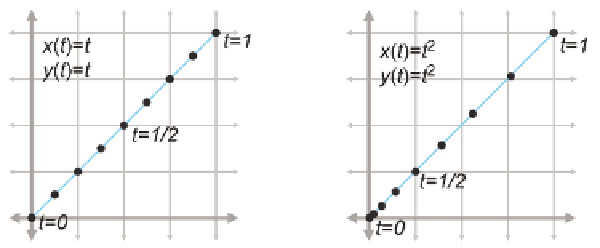Game Development Reference
In-Depth Information
Figure 13.1.
Two curves that define the same “shape,” but not the same “path”
If we are using a curve as a shape and not a path, then this repa-
rameterization doesn't have a visible effect. But that doesn't mean that
the derivatives of the curve are irrelevant in the context of shape design.
Imagine that we are creating a font using a curve to define a segment of
the letter S. In this instance, we might not care about the velocity at any
point, but we would care very much about the tangent of the line at any
given point. The tangent at a point is the direction the curve is moving at
that point, the line that just touches the curve. The tangent is basically
the normalized velocity of the curve. Let's formally define the tangent of a
curve to be the unit vector pointing in the same direction as the velocity:
t
(t) =
v
(t) =
v
(t)
v
(t)
.
Higher derivatives also have geometric meaning. The second derivative
is related to curvature, which is sometimes denoted κ, the lowercase Greek
letter kappa. We can define a measure of curvature by considering a circle
of a given radius. A circle with radius r has curvature equal to κ = 1/r
everywhere on the circle. A straight portion of a curve has zero curvature,
which can be interpreted as the curvature of a circle with infinite radius.
The curvature is computed by the formula
The tangent vector
v
(t) ×
a
(t)
v
(t)
3
Curvature
κ(t) =
.
13.2
Polynomial Interpolation
You are probably already familiar with linear interpolation. Given two
“endpoint” values, create a function that transitions at a constant rate









Search WWH ::

Custom Search